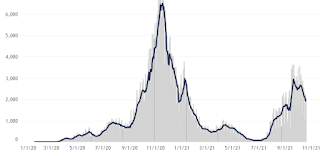You may recall that
the Wisconsin GOP have passed a Joint Resolution laying out how they wanted to re-gerrymander the State Legislature for the 2020s. And no surprise, but the WisGOPs want to continue with the current rigged maps as much as possible.
3. Retain as much as possible the core of existing districts, thus maintaining existing communities of interest, and promoting the equal opportunity to vote by minimizing disenfranchisement due to staggered Senate terms.
This will be likely be the basis of their argument to the Wisconsin Supreme Court for drawing new maps, and so I wanted to take a look to see what it might be looked like to draw up a map that way.
Obviously, the maps wouldn't be very different than the gerrymandered mess that we have today. Let me remind you what that looks like. First the Assembly.
Looking at the 2016-2020 composite voting numbers in Wisconsin (as outlined by
the Dave's Redistricting site), the current maps break down as follows, based on who got the most votes in statewide races in each of those districts:
Assembly GOP 61, Dem 38
Senate - GOP 22, Dem 11
This is despite Dems having around a 1% advantage in that 2016-2020 composite vote. Some of this is simple geographic packing (Dems have 80-90% of the vote in districts, GOPs have no more than 71%), but the real way the gerrymander shows itself is in the number of close districts that lean GOP.
Assembly current maps
Win by 0-5% - GOP 7, Dem 4
Win by 5-10% - GOP 8, Dem 4
Senate current maps
Win by 0-5% GOP 4, Dem 1
Win 5-10% GOP 3, Dem 1
So keep those numbers in mind, and then take a look at what I drew up. Starting with the statewide map.
And then the Milwaukee area in particular.
The loss of population in the City of Milwaukee is apparent here, districts on the north side (especially) have to grow in geography to make up for the loss of people. So city-based districts are now absorbing suburbs like Brown Deer and Glendale, which ironically may help Republicans who got too cute in the last gerrymander, and ended up making more districts competitive by trying to combine those areas with pro-GOP suburbs to the north.
You can also see where the growth in the Madison area shrinks those districts, particularly in the western half of the county. This likely will benefit Dems, as more districts have to include blue territory than they do now, and likely would sink current GOPs from Lodi and Dodgeville that have seats today.
Put it together, and the GOP would maintain their lopsided advantage in the Assembly.
Total districts - GOP 61, Dem 38 (no change)
Win by 0-5% - GOP 9, Dem 4 (GOP +2)
Win by 5-10% - GOP 7, Dem 5 (GOP -1, Dem +1)
The Senate combines 3 Assembly districts into 1, and here's what that current map looks like.
The main difference with my updated districts is that you will see is how Jon Erpenbach's district gets confined mostly to western Dane County instead of going to Baraboo and Portage under the current gerrymander, and how the districts around there have to get closer to Madison as a result.
And Milwaukee County has fewer places that have bleed over from the WOW counties, as the Milwaukee districts have to grow in geography to make up for the loss of people.
Put that together, and the GOP maintains their 2-to-1 advantage in the Senate.
Total districts - GOP 22, Dem 11 (no change)
Win by 0-5% - GOP 4, Dem 1 (no change)
Win by 5-10% - GOP 2, Dem 1 (GOP -1)
Interestingly, all 5 of the closest districts would be up for re-election in 2022, with none in the 2024 cycle.
You can see why WisGOPs want to keep this as the basis for redistricting. It takes Dems winning around 54-55% of the vote to flip either of these chambers (and in the Senate, it would be 2 elections in a row), which helps explain why GOPs spend more time worrying about the 20%ers frothing at the mouth (since those dipshits vote in low-pturnout primaries), than they do the middle 5% of voters.
As I've mentioned before, "fair maps" in Wisconsin don't mean that the breakdown is 50-50 for seats (it's more like 57-42 in Assembly and 20-13 for the Senate). But it does mean that Dems only need 52-53% to flip, and that the close districts are a near-even split between Dem and GOP.
That's what needs to be adjusted, and "just vote harder" isn't an adequate response if the GOPs are allowed to rig things for the next 10 years.







































